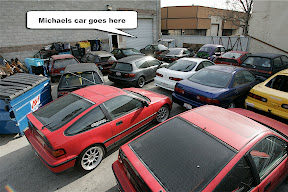
I get more emails and instant messages asking about my B20 tune than just about other subject. Except maybe Viagra offers...
It's a pretty basic set-up. And I think that's what so many people like about it. It's just a full displacement, non-VTEC, CRV engine stuffed in a 2000lb Civic. No trickery. Nothing fragile, rare or unique. Just a pure, honest engine swap that anyone could do. Plug and play.
That graph above was done when the B20 was first put in the car at the beginning of the '06 season. Here's the recipe:
• AEM cold air intake
• DC 4-2-1 header thru 2.25" exhaust
• Dyno tuned with a Hondata S300 (by Doug from Hondata)
• 310cc injectors from TunerToys
• AEM adjustable fuel pressure reg
That's it. The engine is a stock, low compression JDM B20 with the regular head, LS type manifold, stock (58mm?) throttle body and stock cams. We did run adjustable cam gears and fiddled with the valve timing. But it responded poorly, and in the end made better power with the stock cam timing of 0/0.
I would run this swap on the street. I'd put it in my mother's car. And I ran all of last season in H1. The only mechanical issue I had was a broken alternator belt. I did get my ass handed to me by the 220hp K-motors in H1. But I had more track time and lower maintenance than anyone. Swaps like this are why the new H2 rules for Honda Challenge are going to be the "next, new thing".
What's left on the table:
On top of the oh-so-simple formula above, the new H2 rules allow a few other tweaks that have potential for even more power:
• 62mm throttle body
• Blox Type-R style intake manifold
• higher compression B20"z" pistons
• head to manifold match porting (1" on either side of the gasket allowed)
• bigger valve P8R cylinder head
The last item, the P8R head, is a current loophole in the rules that I don't expect will last. Some of the internet community have made that head out to be something very precious and rare. It's really not. P8R heads are coming in on a lot of the JDM import B20 engines and are selling for the same price as all the rest. The P8R intake valves are a couple of millimeters larger than the regular LS and B20b/z heads, so there's an obvious advantage. It's a safe bet that when the first guy with a P8R casting starts kicking everyone's ass, there will be a weight penalty assigned. And that would be fair. I'd hate to see it banned. I just don't want to see it become a "must have" item, either.
So there's be more to try when time allows. My B20 is a long way from being optimized. Still, it's a simple, affordable plug-in that gives better power per dollar than just about anything else in Honda Challenge. And elsewhere, too.




